The Choir Books of San Giorgio Maggiore in Venice: Results of in Depth Non-Invasive Analyses
Abstract
:1. Introduction
2. Methods and Materials
2.1. Analytical Protocol
2.2. The Manuscripts
3. Results
3.1. Overview
3.2. Illuminations Attributed to Cristoforo Cortese
3.3. The Identification of Smalt in Miniatures Attributed to the Master of Antiphonary Q
3.4. The Identification of Metallic Bismuth in Decorative Borders
4. Discussion
4.1. Cristoforo Cortese’s Palette
4.2. The Use of Smalt in 15th-Century Venetian Miniatures
4.3. The Use of Metallic Bismuth in Decorative Borders
5. Conclusions
Supplementary Materials
Author Contributions
Funding
Acknowledgments
Conflicts of Interest
References
- Ricciardi, P.; Schmidt Patterson, C. Science of the Book. In A Handbook of the Art and Science of Illuminated Manuscripts; Panayotova, S., Ed.; Harvey Miller/Brepols: London, UK; Turnhout, Belgium, forthcoming.
- Pessanha, S.; Manso, M.; Carvalho, M.L. Application of spectroscopic techniques to the study of illuminated manuscripts: A survey. Spectrochim. Acta Part B 2012, 71–72, 54–61. [Google Scholar] [CrossRef]
- Aceto, M.; Agostino, A.; Fenoglio, G.; Idone, A.; Gulmini, M.; Picollo, M.; Ricciardi, P.; Delaney, J.K. Characterisation of colourants on illuminated manuscripts by portable fibre optic UV-visible-NIR reflectance spectrophotometry. Anal. Methods 2014, 6, 1488–1500. [Google Scholar] [CrossRef]
- Taccetti, F.; Castelli, L.; Czelusniak, C.; Gelli, N.; Mazzinghi, A.; Palla, L.; Ruberto, C.; Censori, C.; Lo Giudice, A.; Re, A.; et al. A multipurpose X-ray fluorescence scanner developed for in situ analysis. Rend. Lincei Sci. Fis. Nat. 2019, 30, 307–322. [Google Scholar] [CrossRef]
- Bell, I.M.; Clark, R.J.H.; Gibbs, P.J. Raman spectroscopic library of natural and synthetic pigments (pre- ~ 1850 AD). Spectrochim. Acta Part A 1997, 53, 2159–2179. [Google Scholar] [CrossRef]
- Burgio, L.; Clark, R.J.H. Library of FT-Raman spectra of pigments, minerals, pigment media and varnishes, and supplement to existing library of Raman spectra of pigments with visible excitation. Spectrochim. Acta Part A 2001, 57, 1491–1521. [Google Scholar] [CrossRef]
- Toniolo, F.; Ponchia, C. L’InCanto Della Miniature. I Corali di San Giorgio Maggiore a Venezia, 2020; forthcoming.
- Caggiani, M.C.; Cosentino, A.; Mangone, A. Pigments Checker version 3.0, a handy set for conservation scientists: A free online Raman spectra database. Microchem. J. 2016, 129, 123–132. [Google Scholar] [CrossRef]
- García-Bucio, M.A.; Casanova-González, E.; Ruvalcaba-Sil, J.L.; Arroyo-Lemus, E.; Mitrani-Viggiano, A. Spectroscopic characterization of sixteenth century panel painting references using Raman, surface-enhanced Raman spectroscopy and helium-Raman system for in situ analysis of Ibero-American Colonial paintings. Philos. Trans. R. Soc. A 2016, 374, 20160051. [Google Scholar] [CrossRef] [PubMed]
- Ricciardi, P.; MacLennan, D.; Bertolotti, G.; Bucklow, S.; Delaney, J.K.; Dooley, K.; Gabrieli, F.; Schmidt Patterson, C. A non-invasive multi-analytical study of the limits of detection of smalt in ultramarine mixtures. Herit. Sci. manuscript in preparation.
- Trentelman, K. A note on the characterization of bismuth black by Raman microspectroscopy. J. Raman Spectrosc. 2008, 40, 585–589. [Google Scholar] [CrossRef]
- Burgio, L.; Clark, R.J.H.; Hark, R.R.; Rumsey, M.S.; Zannini, C. Spectroscopic Investigations of Bourdichon Miniatures: Masterpieces of Light and Color. Appl. Spectrosc. 2009, 63–66, 611–620. [Google Scholar] [CrossRef] [PubMed]
- Panayotova, S. Cristoforo Cortese in Cambridge. In Miniatura. Lo Sguardo e la Parola: Studi in Onore di Giordana Mariani Canova; Toniolo, F., Toscano, G., Eds.; Silvana Editoriale: Cinisello Balsamo, Italy, 2012; pp. 189–190. [Google Scholar]
- Morgan, N.; Panayotova, S.; Reynolds, S. (Eds.) A Catalogue of Western Book Illumination in the Fitzwilliam Museum and the Cambridge Colleges. Part Two: Italy and the Iberian Peninsula; Harvey Miller/Brepols: London, UK; Turnhout, Belgium, 2011. [Google Scholar]
- Medica, M.; Toniolo, F. (Eds.) Le Miniature della Fondazione Giorgio Cini; Silvana Editoriale: Cinisello Balsamo, Italy, 2016. [Google Scholar]
- Panayotova, S. (Ed.) COLOUR. The Art and Science of Illuminated Manuscripts; Harvey Miller/Brepols: London, UK; Turnhout, Belgium, 2016. [Google Scholar]
- Berrie, B.H. Mining for Color: New Blues, Yellows, and Translucent Paint. Early Sci. Med. 2015, 20, 308–334. [Google Scholar] [CrossRef] [Green Version]
- Mühlethaler, B.; Thissen, J. Smalt. In Artists’ Pigments. A Handbook of Their History and Characteristics; Roy, A., Ed.; National Gallery of Art: Washington, DC, USA, 1993; Volume 2, pp. 113–130. [Google Scholar]
- Seccaroni, C.; Haldi, J.-P. Cobalto, Zaffera, Smalto Dall’antichità al XVIII Secolo; Laboratorio Tecnografico ENEA: Frascati, Italy, 2016; pp. 11–32, 45–64. [Google Scholar]
- Trentelman, K.; Turner, N. Investigation of the painting materials and techniques of the late-15th century manuscript illuminator Jean Bourdichon. J. Raman Spectrosc. 2009, 40, 577–584. [Google Scholar] [CrossRef]
- Dřevíkovská, J.; Ohlídalová, M.; Boldan, K. Srovnání Vzácných Iluminovaných Rukopisů Připisovaných Mistru Šelmberské Bible (Comparison of Precious Illuminated Manuscripts Attributed to ‘Master of Šelmberk Bible’); Sborník z Konference Konzervátorů a Restaurátorů; Technické museum v Brnĕ: Brno, Czech Republic, 2008; pp. 61–67. [Google Scholar]
- Čechák, T.; Trojek, T.; Šefců, R.; Chlumská, Š.; Třeštíková, A.; Kotrlý, M.; Turková, I. The use of powdered bismuth in Late Gothic painting and sculpture polychromy. J. Cult. Herit. 2015, 16, 747–752. [Google Scholar] [CrossRef]
- Spring, M.; Grout, R.; White, R. ‘Black Earths’: A Study of Unusual Black and Dark Grey Pigments used by Artists in the Sixteenth Century. Natl. Gallery Tech. Bull. 2003, 24, 96–114. [Google Scholar]
- Gold, R. Reconstruction and Analysis of Bismuth Painting. In Painted Wood: History and Conservation, Proceedings of a Symposium Organized by the Wooden Artifacts Group of the American Institute for Conservation of Historic and Artistic Works; Dorge, V., Howlett, F.C., Eds.; Getty Conservation Institute: Los Angeles, CA, USA, 1998; pp. 166–178. [Google Scholar]
- Turner, N.K.; Schmidt Patterson, C. New Discoveries in the Painting Materials in the Medieval Mediterranean: Connections between Manuscript Illumination and Glass Technology during the Byzantine Era, c.1100–1300. In Manuscripts in the Making Art and Science; Panayotova, S., Ricciardi, P., Eds.; Harvey Miller/Brepols: London, UK; Turnhout, Belgium, 2017; Volume 1, pp. 187–199. [Google Scholar]
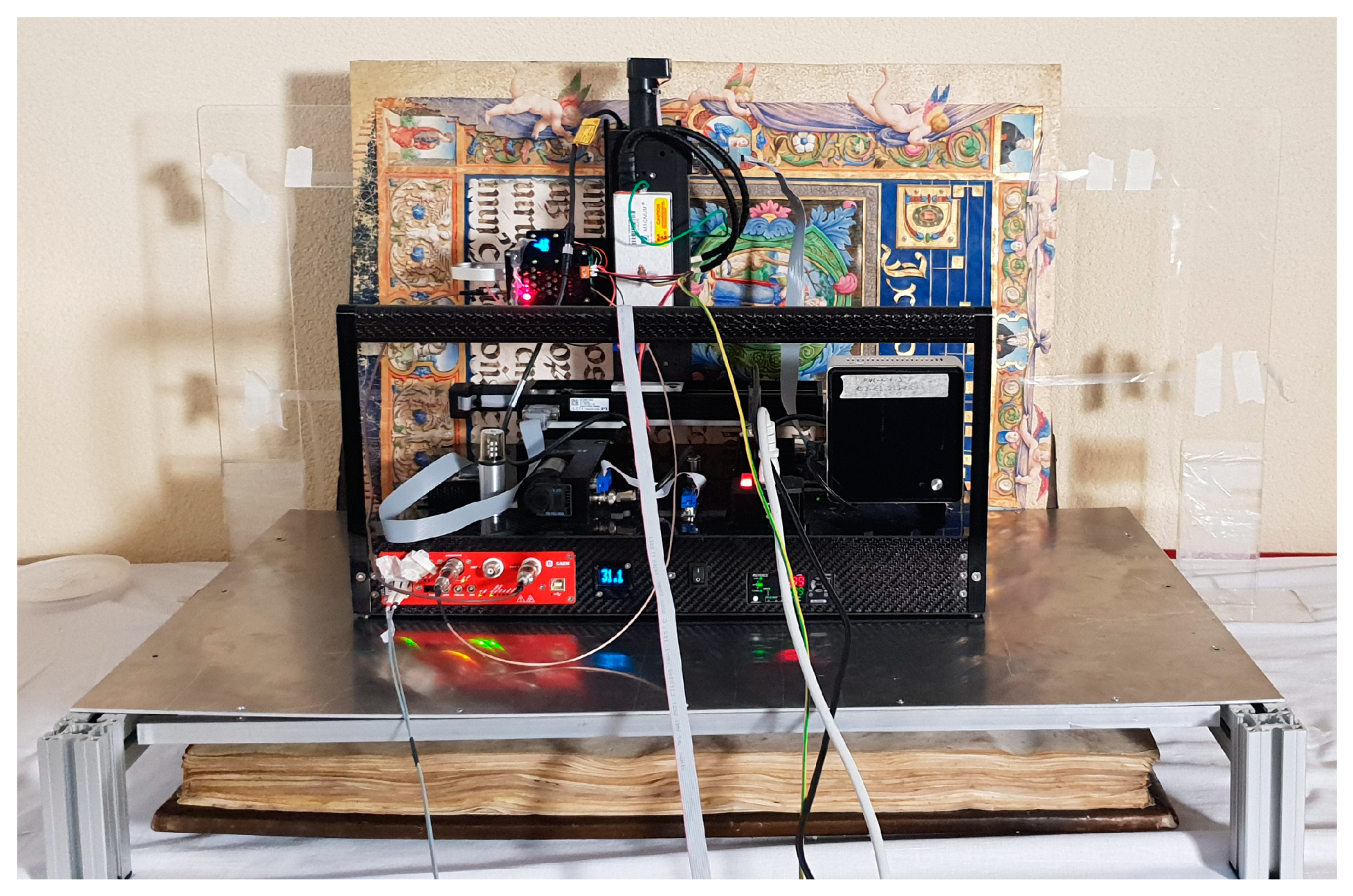
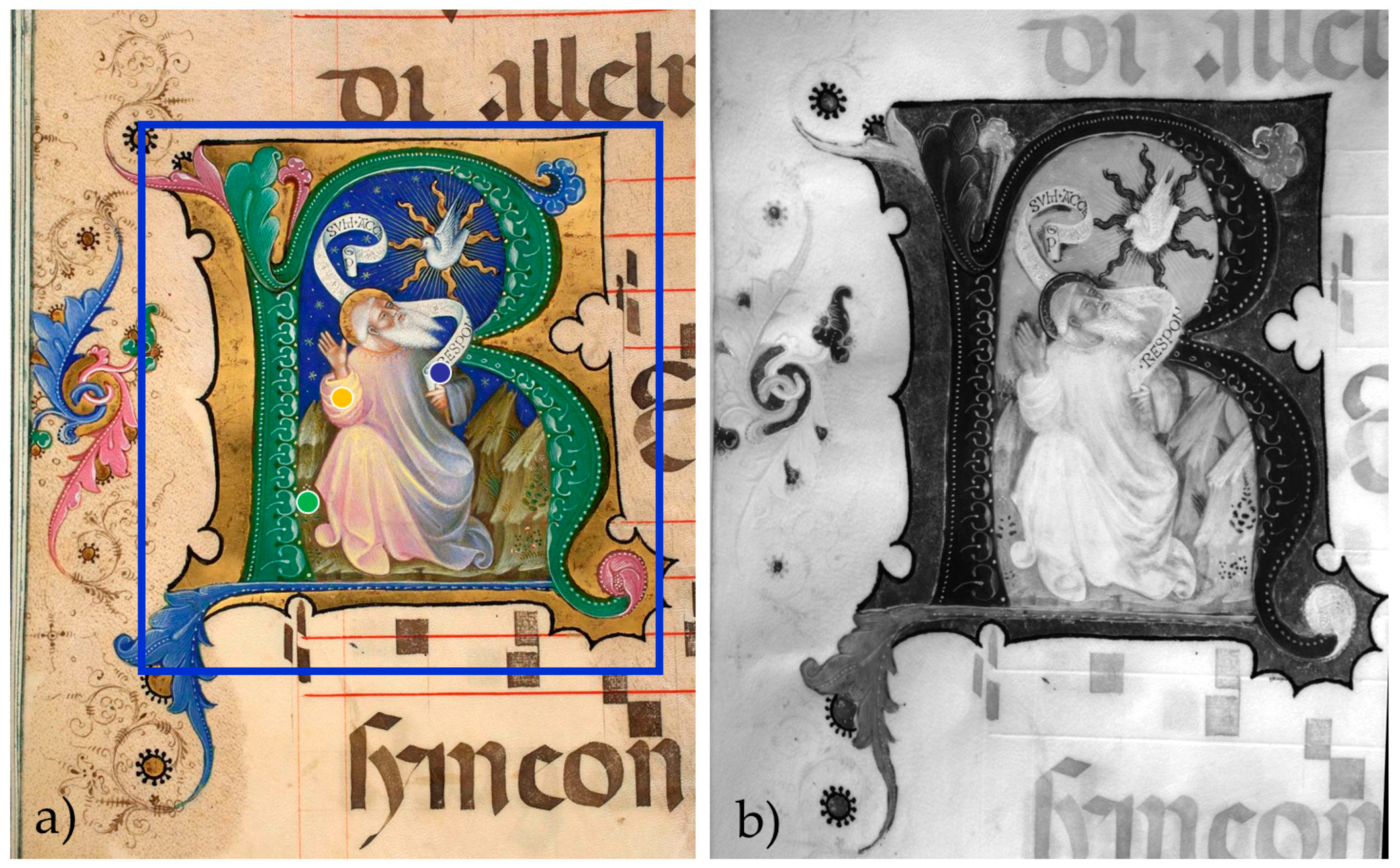

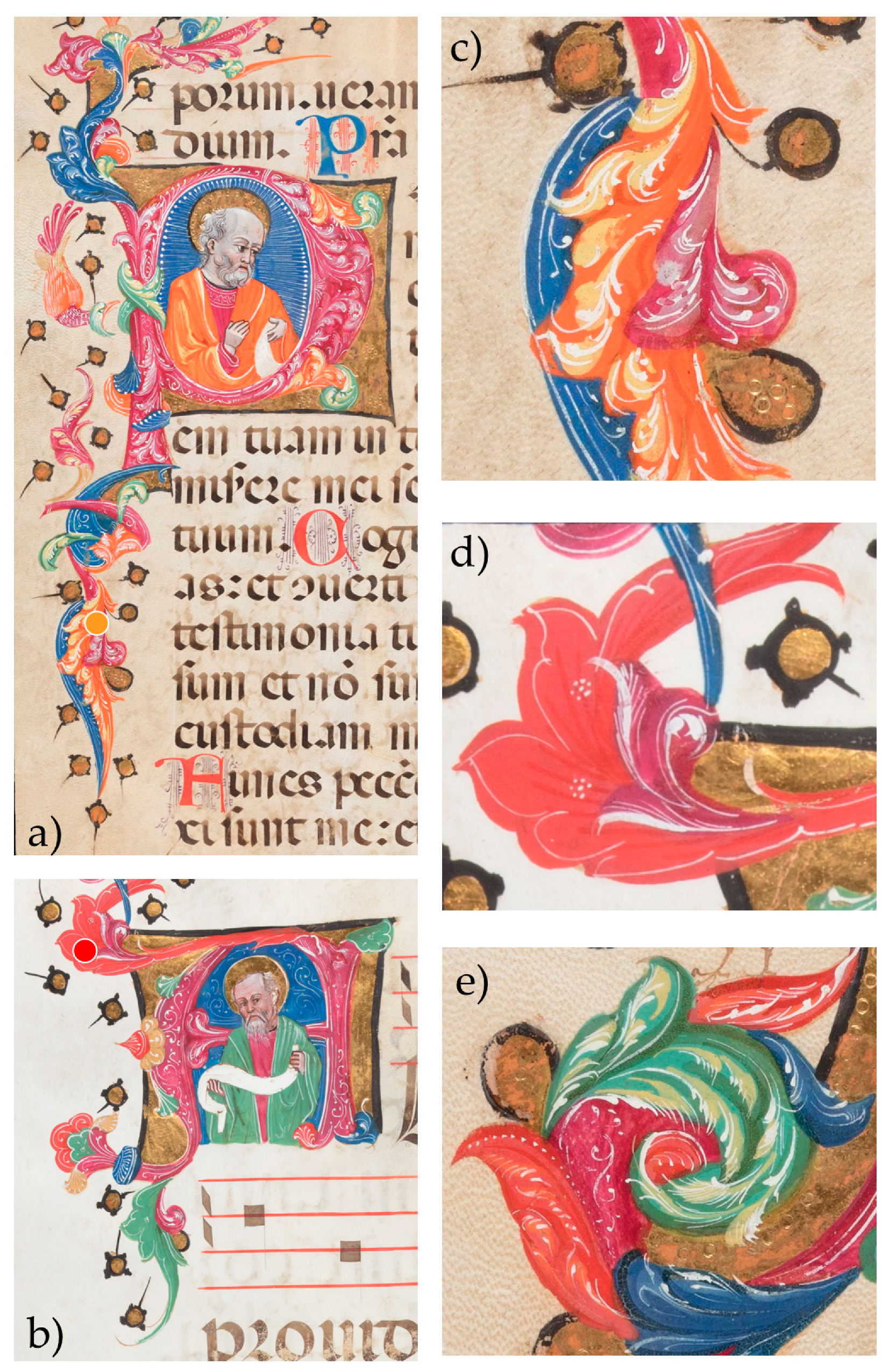
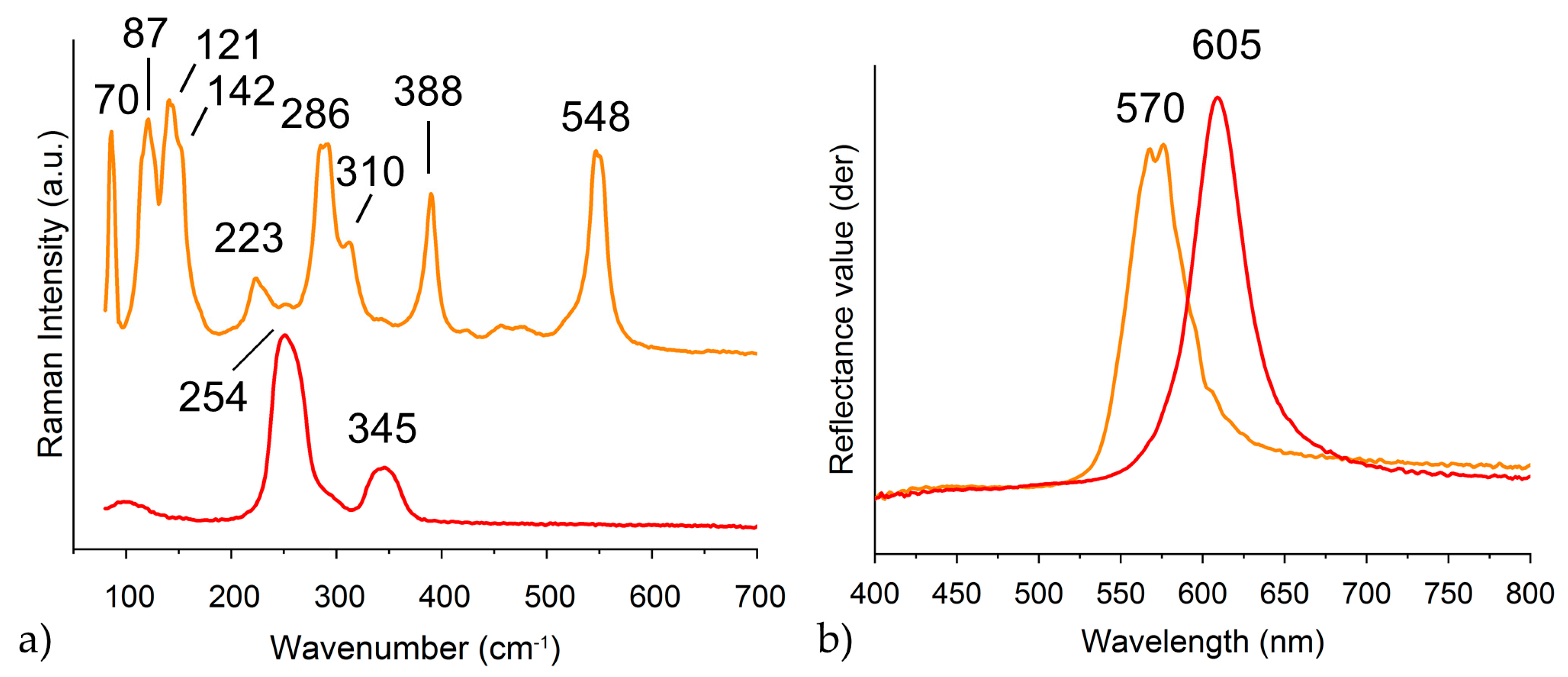
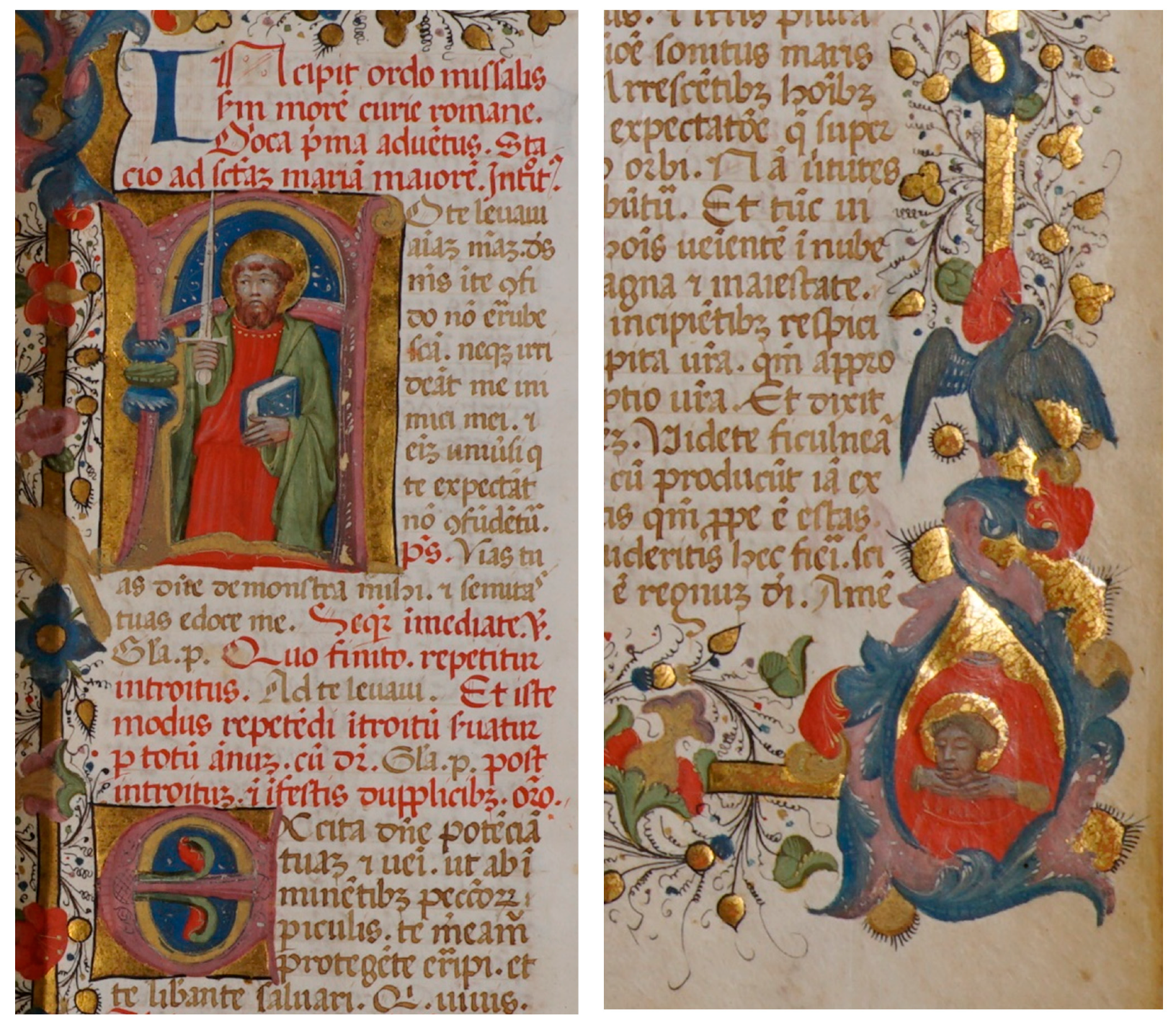

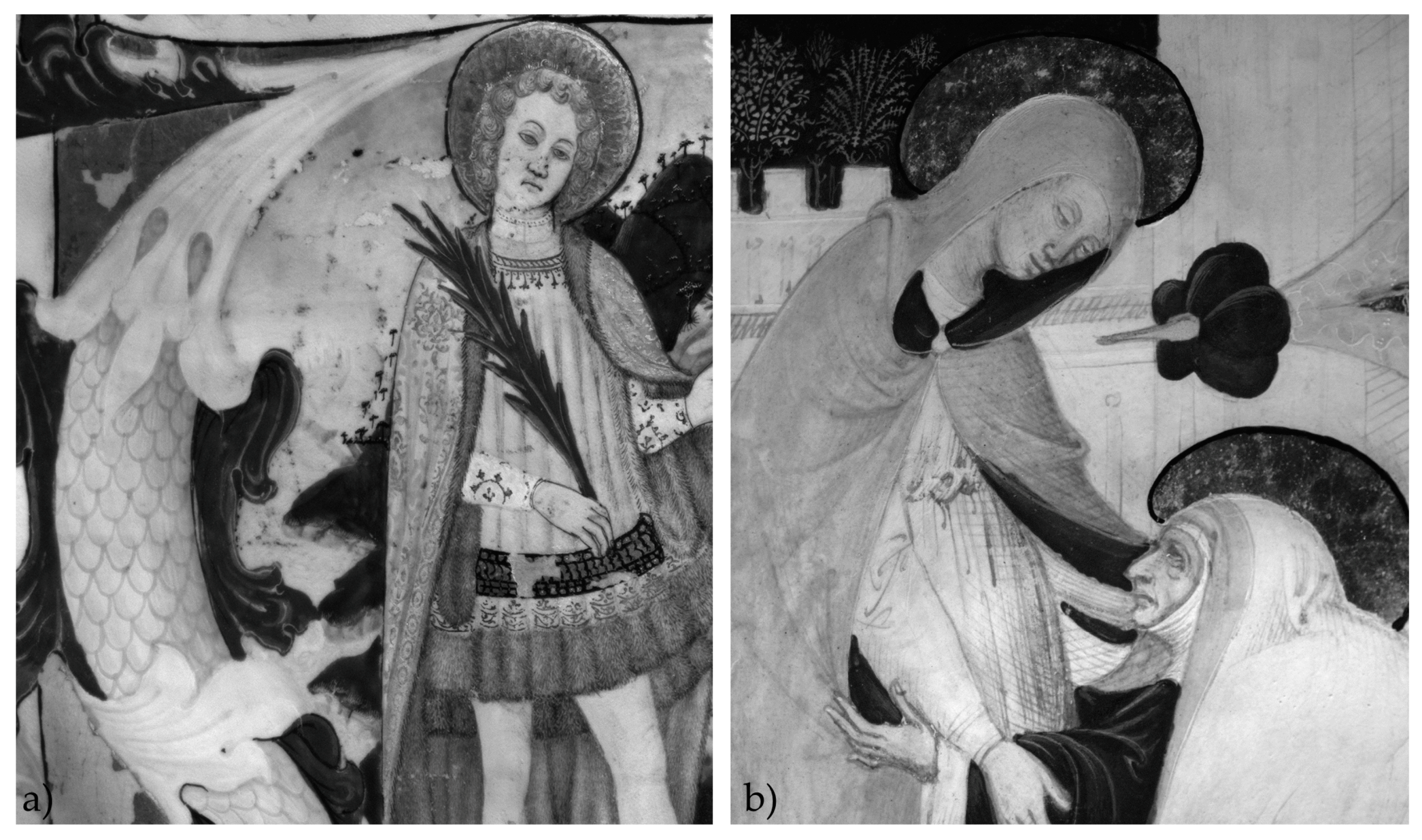


| Volume/Folio | Artist* | Lead White | Red Lead | Vermilion | Lead Tin Yellow I | Organic Red Dye | Purple Organic Dye | Ultramarine | Ultramarine + Smalt | Azurite | Indigo | Malachite | Bismuth | Mosaic Gold | |
|---|---|---|---|---|---|---|---|---|---|---|---|---|---|---|---|
| M | 2v | Belbello | X | X | X | X | X | ||||||||
| 8v | Ant. Q M. | X | X | X | X | X | X | X | X | n/a | X | ||||
| 30r | Ant. M M. | X | X | X | X | X | X | X | |||||||
| 32v | Ant. M M. | X | X | X | X | X | X | X | X | X | |||||
| 77v | Belbello | X | X | X | X | X | X (+ LTY) | ||||||||
| Q | 5v | Ant. Q M. | X | X | X | X | X (+ LTY) | n/a | |||||||
| 8r | Ant. Q M. | X | X | X | X | X (+ LTY) | n/a | ||||||||
| 12v | Ant. Q M. | X | X | X | X (+ LTY) | n/a | |||||||||
| 29v | Ant. Q M. | X | X | X | X | X | X (+ LTY) | X | X | ||||||
| q | 2v | Ant. Q M. | n/a | n/a | n/a | X | X | n/a | |||||||
| R | 1v | Ant. Q M. | X | X | X | X | X | X | X | X | |||||
| 67v | French | X | X | X | |||||||||||
| 72v | French | X | X | X | X | X | X | X | |||||||
| B | 27v | Ant. Q M. | X | X | X | X | X | X | |||||||
| AE | 21v | Ferrarese M. | X | X | X | X | X | X | X (+ Az) | X | |||||
| 64v | Osservanza M. | X | X | X | X | X | X | X | X | ||||||
| 65v | Ant. Q M. | X | X | X | X | X | X | X | X | X | X | ||||
| K | 1r | Ferrarese M. | X | X | X | X | |||||||||
| N | 7v | Cortese | X | X | X | X | X | X | X | X | |||||
| 17v | Cortese | X | X | X | X | X | X | n/a | |||||||
| 20v | Cortese | X | X | X | X | X | |||||||||
| 36r | Cortese | X | X | X | X | X | X | n/a | |||||||
| 99r | Cortese | X | X | X | X (+Az) | ||||||||||
| 107v | Cortese | X | X | X | X | X | n/a | ||||||||
| 150r | Cortese | X | X | X | X (+ Az) | X | |||||||||
| Missal CXII | 1r | Cortese | X | X | X | X | |||||||||
| 100r | Cortese | X | X | X | X | ||||||||||
| Lead White | Red Lead | Vermilion | Lead Tin Yellow I | Lead Oxide Yellow | Organic Red Dye | Ultramarine | Ultramarine + Smalt | Azurite | Verdigris | Copper Sulphate | Azurite + Lead Tin Yellow | Mosaic Gold | |
|---|---|---|---|---|---|---|---|---|---|---|---|---|---|
| FM Marlay cutting It. 20 | X | X | (ink only) | X | X | X | X | X | |||||
| FM Marlay cutting It. 62 | X | X | X | X | X | X | |||||||
| FD 22171 | X | X | X | X | X | X | * | * | |||||
| FM MS McClean 201.17 | X | X | X | X | X | X | X | X |
© 2019 by the authors. Licensee MDPI, Basel, Switzerland. This article is an open access article distributed under the terms and conditions of the Creative Commons Attribution (CC BY) license (http://creativecommons.org/licenses/by/4.0/).
Share and Cite
Ricciardi, P.; Mazzinghi, A.; Legnaioli, S.; Ruberto, C.; Castelli, L. The Choir Books of San Giorgio Maggiore in Venice: Results of in Depth Non-Invasive Analyses. Heritage 2019, 2, 1684-1701. https://doi.org/10.3390/heritage2020103
Ricciardi P, Mazzinghi A, Legnaioli S, Ruberto C, Castelli L. The Choir Books of San Giorgio Maggiore in Venice: Results of in Depth Non-Invasive Analyses. Heritage. 2019; 2(2):1684-1701. https://doi.org/10.3390/heritage2020103
Chicago/Turabian StyleRicciardi, Paola, Anna Mazzinghi, Stefano Legnaioli, Chiara Ruberto, and Lisa Castelli. 2019. "The Choir Books of San Giorgio Maggiore in Venice: Results of in Depth Non-Invasive Analyses" Heritage 2, no. 2: 1684-1701. https://doi.org/10.3390/heritage2020103
APA StyleRicciardi, P., Mazzinghi, A., Legnaioli, S., Ruberto, C., & Castelli, L. (2019). The Choir Books of San Giorgio Maggiore in Venice: Results of in Depth Non-Invasive Analyses. Heritage, 2(2), 1684-1701. https://doi.org/10.3390/heritage2020103





